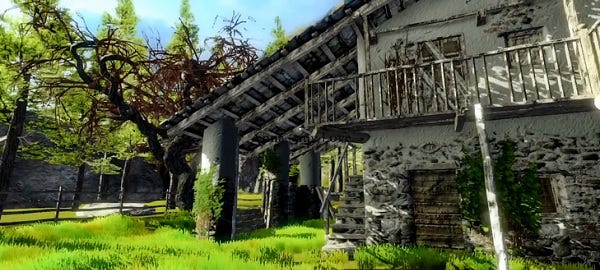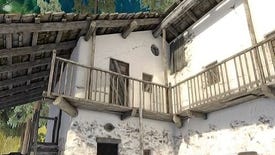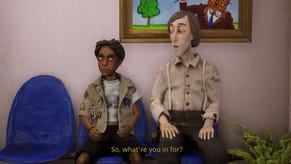Wot I Think: Anna
Care to see sawmill?
Anna, with its single location, reactive horror elements and folklore-based story, seemed like it could be the game to scratch a lot of my itches. After playing through twice, to see how different the scares and the conclusions might be, I'm ready to share wot I think. Am I itch-free or have I got sixteen layers of my own skin sloughed up under my fingernails?
It's the hives, I'm afraid. I've got ants in my pants and welts on my arms from all the scratching I've been doing. Alongside Frictional's output, I was actually reminded of horror adventure Scratches while playing, mostly due to my simple mind drawing comparisons because puzzles were taking place in a haunted building. Unfortunately, Anna suffers from the worst aspects of that sort of inventory-based adventure gaming without offering enough to make its obtuse behaviour entirey tolerable.
With a claim of three hours playtime but with three different routes through the game expanding those three hours to nine, Anna could be a delightfully dread-filled experience, but instead it's a short series of puzzles, some seemingly random bumps in the dark, and a lingering sense of disappointment.
The biggest problem is that the game doesn't have puzzles inventive or logical enough to reward thought and involvement with the story, while also failing to create an environment that offers interesting possibilities for interaction and exploration. It begins so well, on a day so bright and shiny that it's positively next generation, outside the sawmill that is home to mystery and horror. The doors and windows are blocked, so it's clear that finding a way in will be the first difficulty.
Planks cannot be peeled back from windows, rocks cannot be hurled against the rotting door. That's all par for the course in an adventure game, of course, only a specific and unlikely object used in the right place at the right time will open that door, that much is obvious, but by creating a world in which physics exists for some objects but not others, Anna makes its borders and arbitrary rules all the more noticeable.
So much of the plot (no spoilers here) involves ritual that it almost excuses, at least in narrative terms, the use of specific things in specific places, with roles defined by mysticism, but at an early stage I found myself with two knives. One knife could cut some objects, the other couldn't. It's not a massive issue but combined with the vague objectives and hints that the game serves up, that sort of treatment leads to irritating backtracking.
That's backtracking in a game set in a single building. The sawmill is wonderfully recreated with loading screens displaying photographs of the actual place from which the model was copied, but I know it better than I know my own apartment, having wandered from room to room, scouring the darkness for anything of use. Anna quickly becomes a pixel hunt, except instead of manhandling a cursor around the screen, I found myself manhandling a man around a VERY DARK ROOM, looking for the one object that I could interact with.
When I first entered the mill, having spent a good forty minutes collecting pine cones and furiously staring at the brook outside, I was hoping the chills and the sense of place would improve. Nothing frightening happens outside but that's as it should be; it's the tease, the world is the bright antechamber whose every doorway leads to claustrophobia, dread and entombment.
The first room, with its collapsed machinery and splintered furniture, looks both eery and real. Just what I wanted. I started poking around in the corners, only to find that it's mostly filler. There's little to see, little to read, just hotspots to find: a single drawer that can be opened, a couple of items to pick up.
I cheated once, looking up a video walkthrough, because I'd started to solve a puzzle in a sequence that I can only assume was unintended. Because I did one thing before another thing, I was forced to carry around an item that made a constant, repetitive sound. I couldn't drop it, I didn't know where to use it and I had no intention of listening to the (literally) bloody thing while poking my face into every patch of darkness, scraping around on my hands and knees looking for a leaf or the one piece of debris among twenty that could actually be moved. I watched a video walkthrough, I found what I needed. It was a dark object in a pitch black room that I had explored at least twenty times already, somehow missing it because it isn't in a place where I'd expect to find such a thing. It's just on the floor, near to several non-interactive but similar objects.
Now, none of this would matter quite as much as it does if all the creakiness was backed up by a few dollops of creepiness. Unfortunate then that the lack of an actual threat soon meant that no matter how many plant pots were Poltergeisted at my face, I found them an annoyance rather than the chilling pottery assault I'd hoped for. Objects fly, cryptic drawings appear on the walls, there's an occasional jump scare. It's effective at first but soon becomes little more than another block to progress. The story rarely offers decent motivation, so thick with mystery that I wasn't sure why putting that leaf on that particular painted eye was causing a change or allowing progress.
Events seem random, like the wobbling animatronics of a malfunctioning ghost train, rather than reactive. Maybe looking at a certain thing for too long will cause it to move but I never felt like the game was tracking my movements and habits, I just felt like it was rustling through its bag of tricks and lobbing whatever came to hand at me. That's not to say it didn't alarm me at times. Particularly toward the story's end, there are some right horrible things happening in the sawmill but the best of them are the ones that the player is forced to do in order to progress rather than the ones that emerge unexpectedly.
The story and the puzzles are flawed in the same way. Rarely did I feel like my actions had purpose that I understood, I was doing things because there was nothing else to do, all exploration quickly exhausted, not because my actions had meaning. On the second playthrough, when I knew which objects were needed and where they were located, the game took much less than three hours to complete and the alternate storylines seem more like alternate endings, decided late, by certain choices, rather than by any sort of subtle observation.
I've seen reports of framerate issues but didn't have any problems myself. It is an extraordinarily attractive game at times, although given how little there is to see, it'd be more surprising if a lot of effort hadn't been lavished on appearances. The interface, however, is a pain in the backside. Little things like the menu being hidden (anywhere but 'esc' is hidden) and having the inventory be more convoluted than seems necessary are frustrating, and, as an inverter, I feel obliged to point out that I wasn't allowed to fix the unintuitive approach to the y-axis. That's being patched though, as are some of the more vague objectives. That's good and despite all the frustrations, I find myself keen to see what Dreampainters create next.
For all its failings, Anna is an interesting game. The idea of a first-person adventure, horrifying or not, that allows for exploration of a single environment, with this sort of Frictional style physical interaction, is one I've been keen to see for some time. Amnesia took away the weaponry but left the monsters and, brilliant as it was, some of the finest moments were in the quiet and the dark, digging through a room in search of something rather than scrambling down a corridor to escape from something. My issues with Anna aren't in the conception but rather in the lack of interactivity. If the game world is to be so small, it needs to be more interesting to explore, there must be more to see and do, and the story must be a hook rather than a series of cryptic signposts.
Anna is available now.














